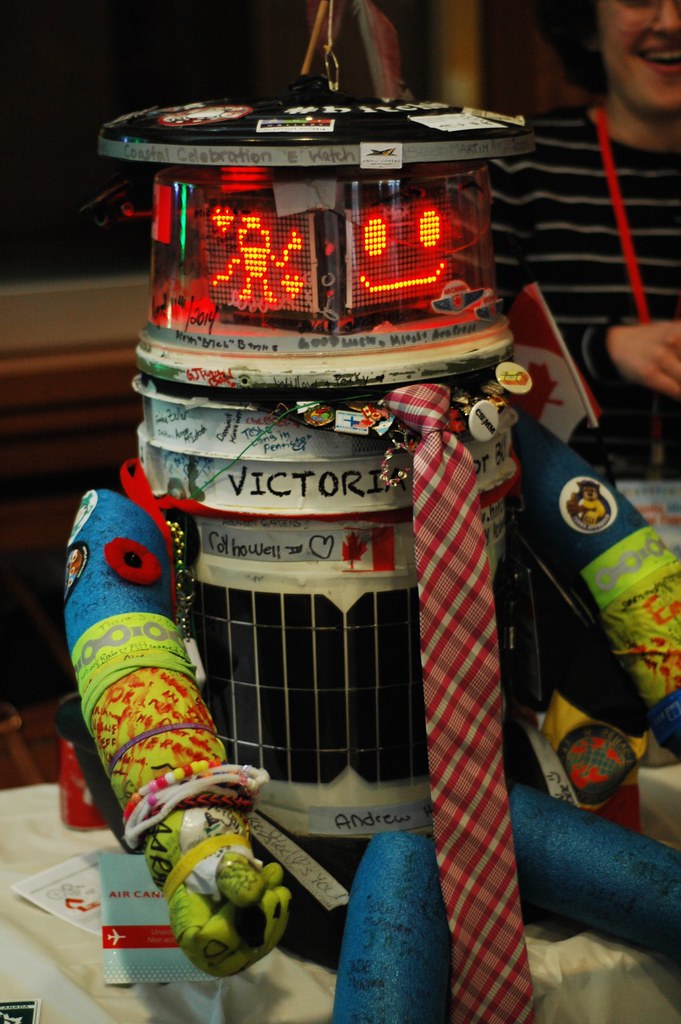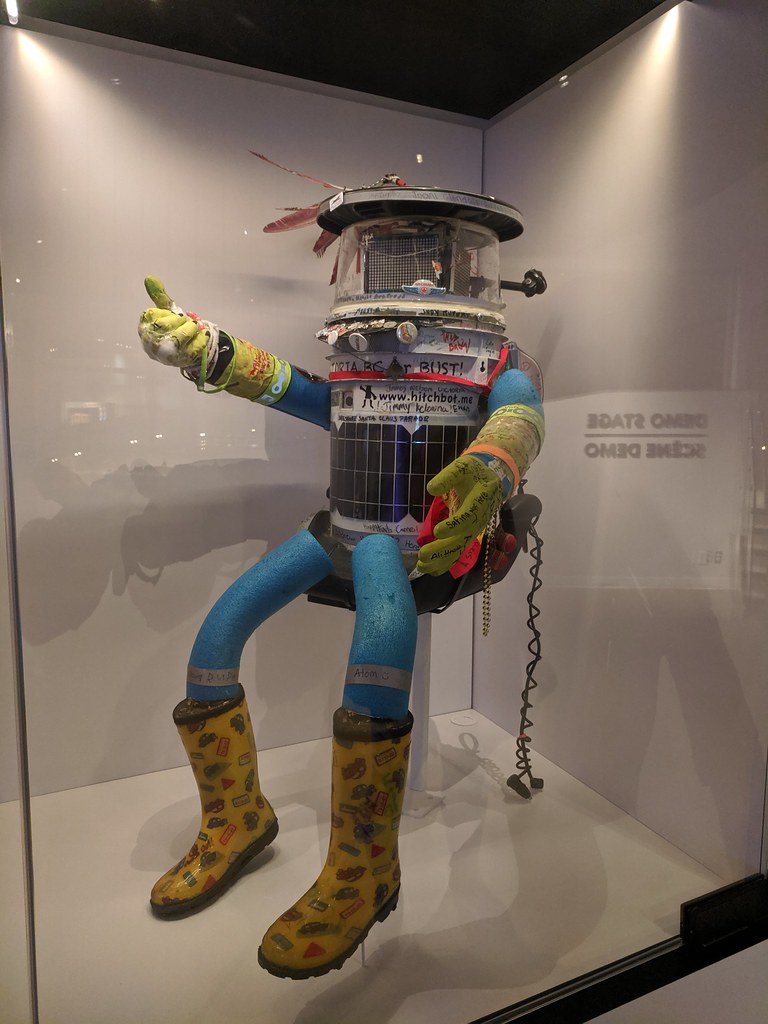In 2013, researchers Frauke Zeller and David Harris Smith created hitchBOT, a hitchhiking robot. At the time, Zeller was an associate professor at the School of Professional Communication at Toronto Metropolitan University (then Ryerson University), and her husband, Smith, was an associate professor in the Department of Communication Studies & Media Arts at McMaster University. By creating hitchBOT, Zeller and Smith aimed to explore the interaction between humans and technology. After successfully hitchhiking across Canada and Europe, hitchBOT made headlines around the world in 2015, when it was destroyed by vandals in Philadelphia. (See also Robotics in Canada.)

Research Purpose and Design
In an article for the journal Leonardo, Frauke Zeller and David Harris Smith stated that the hitchBOT project was “inverting the popular dystopian question of whether we can trust robots, asking instead ‘Can robots trust humans?’” In this way, hitchBOT was both a social experiment and performance art project.
The robot was designed to appear playful and non-threatening, having what its creators called a “yard-sale aesthetic.” Its head was protected by a cake saver, its body was a plastic bucket and its limbs were made of pool noodles, with rubber gloves and Wellington boots. It had an animated LED face and could raise its arm into a hitchhiking position. About the size of a kindergartener, the robot was designed to be easily lifted into a car and was equipped with a child booster seat. Using artificial intelligence, hitchBOT could have basic conversations. The robot was also equipped with a GPS device so that its creators could track its movement and location. It was not the first robot that Zeller and Smith had worked on; a previous project, a robotic art critic called kulturBOT, was sometimes described as hitchBOT’s “older brother.”
Travels
Through Canada
Beginning in Halifax, Nova Scotia, hitchBOT hitched rides across Canada unaccompanied for nearly four weeks, attracting attention wherever it went. The robot ended its journey in Victoria, British Columbia. A couple in Halifax reportedly took hitchBOT on a camping trip, and a group of young men took the robot sightseeing. It even attended a First Nations powwow at Wiikwemkoong Unceded Territory on Manitoulin Island. There, it was given a name in Anishinaabemowin meaning “Iron Woman.” Over the course of its journey, the robot gained a large social media following, with more than 95,000 followers across Twitter (now X), Facebook and Instagram. It became so popular that, when someone took hitchBOT home, its GPS sometimes needed to be disabled so that personal addresses were not made public. People photographed hitchBOT in many creative ways, making it appear as if it was “eating” a dish of screws and nails or using a camper toilet. Some even decorated it with jewelry, and on its flight home, an Air Canada pilot gifted it an official set of pilot wings.
After hitchBOT completed its journey, a second version was built for further trips. The original model was acquired by the Canada Science and Technology Museum in December 2015 for its collections. “[hitchBOT’s] got this great Canadian story, developed at Canadian universities by Canadian researchers, but it also has this great Canadian road-trip story attached to it,” said Tom Everrett, the museum’s curator of communications, adding that “[hitchBOT] might seem a little bit weird or kooky now,” but its story speaks to an important moment in the history of human-robot communications.

Through Europe
In February 2015, the new hitchBOT travelled through Germany, where its journey was followed by a camera crew from the German television broadcaster ProSieben. During this trip, hitchBOT visited Neuschwanstein Castle, was part of a parade float during Cologne’s Carnival and was photographed with members of the Canadian embassy in front of the Brandenburg Gate. In June of the same year, it was taken on an arts and culture “vacation” through the Twente region of the Netherlands, this time travelling with Frauke Zeller and David Harris Smith. There, it visited art museums, had its portrait drawn and conducted a band at the Kulturhus Borne culture centre.
USA Trip and the Destruction of hitchBOT
In July 2015, hitchBOT embarked on a journey across the United States, beginning in Massachusetts, with “San Francisco or Bust” written across its cake saver. (See also Canada and the United States.) Fans could track hitchBOT’s location via GPS, and its journey was recorded on its social media accounts, which were operated by the hitchBOT team. It made several successful stops along the East Coast, crossing items off its “bucket list,” such as “Do the wave at a sports game, anywhere,” which it achieved at Fenway Park in Boston, and “See the lights in Times Square” in New York City.
However, hitchBOT’s journey took a dark turn when it arrived in Philadelphia, where it was dismembered and decapitated on 1 August 2015. Although hitchBOT was programmed to take a photograph every 20 minutes, it did not capture any images of its attacker. Frauke Zeller stated that the robot’s demise could have happened anywhere and did not place any blame on the United States or Philadelphia. A final message appeared on hitchBOT’s Twitter account, reading “My trip must come to an end for now, but my love for humans will never fade. Thanks friends.”
The robot was last seen in the company of Jesse Wellens and Ed Bassmaster, two YouTube vloggers known for pranks. After news of the robot’s destruction was made public, the pair released a security-camera video purported to be of hitchBOT’s dismemberment, but they later admitted it was a hoax, stating that they had not vandalized hitchBOT. They claimed to have created the video as a prank to fool the news media, since journalists had been contacting them for information regarding the attack. The creators of hitchBOT stated that they were not interested in finding the culprit or pressing charges.
Impact
In addition to its large social media following, which eventually grew to over 200,000, hitchBOT’s journeys and its demise were covered by news outlets from around the world. It sparked discussions on robot ethics, including the anthropomorphism of robots, human empathy and the future of interactions between humans and robots. Frauke Zeller and David Harris Smith continued to work on other projects, including Pepper, a childlike robot designed to talk to people about skin cancer prevention. In 2019, hitchBOT was reconstructed as hitchBOT 2.0 and sent to France to star in a play called Killing Robots by director Linda Blanchet. The play’s European tour was cancelled due to the COVID-19 pandemic, though two shows were eventually performed in France in 2022. The culprits behind the attack on hitchBOT remain unknown.

 Share on Facebook
Share on Facebook Share on X
Share on X Share by Email
Share by Email Share on Google Classroom
Share on Google Classroom






